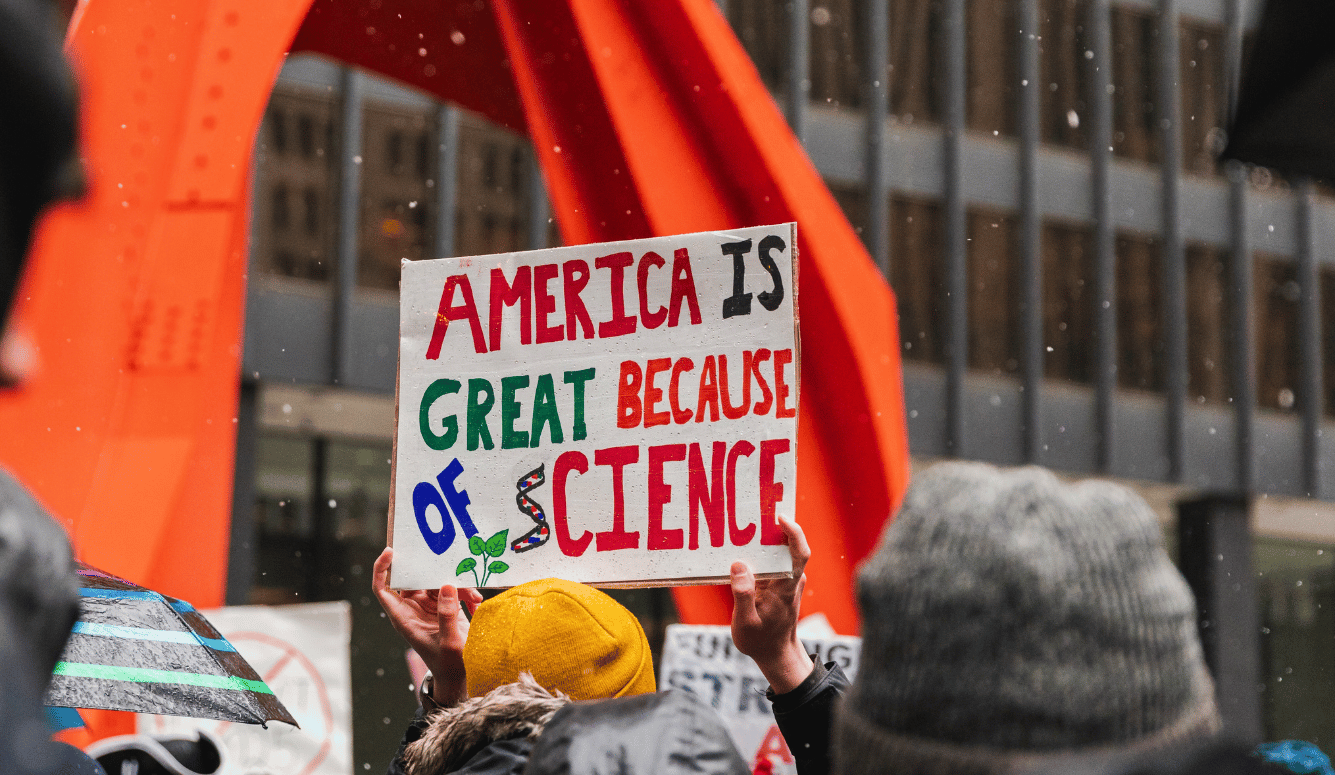Donald Trump and his supporters have neglected the historical role of science as the primary productive force behind America’s economic and military hegemony — an oversight that could put the United States at a disadvantage in the new round of global technological competition.

Stand up for science protest in Chicago’s Federal Plaza, March 7, 2025.
Since Donald Trump began his second term as president, the scientific community in the United States has been thrown into unprecedented turmoil. Trump’s MAGA agenda clashes with the long-held values of the scientific establishment. His attacks on scientific independence, arbitrary cuts to research funding and restrictions on international students have created tensions among scientists and jeopardized America’s position as a global engine of innovation.
While Trump and his supporters frequently recount historical events, they have neglected the historical role of science as the primary productive force behind U.S. economic and military hegemony — an oversight that could put the United States at a disadvantage in the new round of global technological competition.
Trump’s hostility toward the domestic scientific community stems from multiple factors. First, he believes that a substantial portion of science funding is being used to advance the Democratic Party's “woke” — or socially conscious — agenda, including the adoption of diversity, equity and inclusion (DEI) standards for researchers, or the hiring of people who support climate change studies or projects to improve the well-being of the LGBT community. These areas became primary targets for Trump after he took office. Funding for climate monitoring at the Environmental Protection Agency and the National Oceanic and Atmospheric Administration was frozen, and budgets for related programs at the National Institutes of Health and the National Science Foundation were cut significantly.
Second, Trump perceives the American scientific community as deliberately opposing him on major issues, thereby weakening his public support. He continues to harbor resentment toward immunologist Dr. Anthony Fauci, believing that Fauci’s scientific assessments during the 2020 COVID-19 pandemic cast doubt on the administration’s response.
Since Trump returned to power, his supporters have pursued retaliatory investigations against Fauci. In May, Trump signed an executive order to “restore” the “gold standard” for science, which requires that federally funded research should be “transparent, rigorous, and impactful.” While this sounds good, the order in practice creates a pretext for political interference.
Third, the anti-science tendencies of MAGA supporters play a significant role. American media often describe these voters as strongly populist and anti-intellectual — people who view science as an elitist conspiracy. The MAGA movement emphasizes “America first,” cultural conservatism and anti-immigrant sentiment, all of which clash with the scientific community’s calls for openness, diversity and international cooperation.
MAGA's anti-science tendencies are most evident in the “Make America Healthy Again” — or MAHA — plan, which has been vigorously promoted by Trump and the new NIH director Robert Kennedy Jr. The plan consists of a series of health guidelines that lack scientific validity, such as omitting infectious disease control from the core agenda and linking autism to vaccines. Trump, once again, has withdrawn the United States from the Paris agreement and the World Health Organization, further isolating the country from global efforts to address climate change and public health crises.
Finally, Trump’s expressed belief that “science is useless” has reinforced the trend. Approaching national interests with a business-minded perspective, Trump prioritizes short-term gains while underestimating long-term factors and potential impacts. Between science and technology, Trump favors applied industrial technology over basic scientific research, pushing to relax regulatory barriers for cutting-edge technologies and accelerate the development of related industries in the United States. To some extent, this approach conflicts with the scientific community’s long-standing commitment to scientific ethics, principles of prudence and empirical evidence, thereby squeezing the space for independent research.
The impact of Trump’s crackdown on the science sector will become apparent over time:
On one hand, the administration’s heavy-handed interventions are reshaping the ecosystem and culture of American science. As a result of “America first,” the sector has grown more insular, showing a significant decline in its willingness to engage in international collaboration and becoming a less reliable international partner.
Trump has also placed MAGA supporters in leadership positions at research institutions, undermining both the independence and scientific rigor of their work. At the same time, commercial influence over American science is likely to increase as more American scientists leave academia to work at technology companies. While this may promote industry development in the short term, it risks eroding the long-standing advantages the United States has enjoyed in basic science.
On the other hand, a brain drain from the U.S. scientific community is emerging as a long-term trend. Cuts in research funding, a deteriorating scientific environment, restrictions on international cooperation and the expulsion of international students are making the U.S. increasingly unattractive as a destination for researchers. According to the international scientific journal Nature, 75 percent of U.S. scientists are thinking about leaving the country, with Canada and the European Union as the primary destinations. Meanwhile, many European countries have launched talent recruitment programs targeting U.S. scientists. China, which strongly supports basic scientific research and values the scientific spirit, may also become an attractive destination.
Before World War II, a large number of European scientists relocated to the United States and became the backbone of its scientific community. They drove major breakthroughs, including the Manhattan Project and the Apollo moon landings and laid the technological and military foundation of U.S. hegemony. Now, history seems to be repeating itself.
